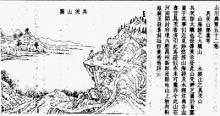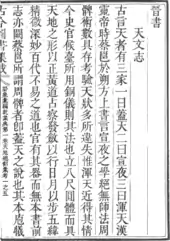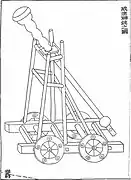Complete Classics Collection of Ancient China
The Complete Classics Collection of Ancient China (or the Gujin Tushu Jicheng) is a vast encyclopedic work written in China during the reigns of the Qing dynasty emperors Kangxi and Yongzheng. It was begun in 1700 and completed in 1725. The work was headed and compiled mainly by scholar Chen Menglei (陳夢雷). Later on the Chinese painter Jiang Tingxi helped work on it as well.

The encyclopaedia contained 10,000 volumes. Sixty-four imprints were made of the first edition, known as the Wu-ying Hall edition. The encyclopaedia consisted of 6 series, 32 divisions, and 6,117 sections.[1] It contained 800,000 pages and over 100 million Chinese characters,[2] making it the largest leishu ever printed. Topics covered included natural phenomena, geography, history, literature and government. The work was printed in 1726 using copper movable type printing. It spanned around 10 thousand rolls (卷). To illustrate the huge size of the Complete Classics Collection of Ancient China, it is estimated to have contained 3 to 4 times the amount of material in the Encyclopædia Britannica Eleventh Edition.[3]
In 1908, the Guangxu Emperor of China presented a set of the encyclopaedia in 5,000 fascicles to the China Society of London, which has deposited it on loan to Cambridge University Library.[4] Another one of the three extant copies of the encyclopedia outside of China is located at the C.V. Starr East Asian Library at Columbia University. A complete copy in Japan was destroyed in the 1923 Great Kantō earthquake.
One of Yongzheng's brothers patronised the project for a while, although Yongzheng contrived to give exclusive credit to his father Kangxi instead.
Name
The Complete Classics Collection of Ancient China is known as the Gujin Tushu Jicheng (traditional Chinese: 古今圖書集成; simplified Chinese: 古今图书集成; pinyin: Gǔjīn Túshū Jíchéng; Wade–Giles: Ku-chin t'u-shu chi-ch'eng; lit. 'complete collection of illustrations and books from the earliest period to the present') or Qinding Gujin Tushu Jicheng (Chinese: 欽定古今圖書集成)[5] in Chinese, also translated as the Imperial Encyclopaedia, the Complete Collection of Ancient and Modern Illustrations and Texts, the Complete Collection of Ancient and Modern Writings and Charts, or the Complete Collection of Illustrations and Writings from the Earliest to Current Times.
Compilation

The Kangxi Emperor hired Chen Menglei of Fujian to compile the encyclopedia. From 1700 to 1705, Chen Menglei worked day and night, writing most of the book, including 10,000 volumes and around 160 million words. It was originally titled the Compendium or Tushu Huibian (图书汇编). By 1706 the book's first draft was completed, and the Kangxi emperor changed the title to Complete Classics Collection of Ancient China (Gujin Tushu Jicheng). When the Yongzheng emperor ascended the throne, he ordered Jiang Tingxi to help Chen Menglei finish the encyclopedia for publication by around 1725.[6]
Outline
The 6 series are as follows.[7]
- Heavens/Time/Calendrics (历象): Celestial objects, the seasons, calendar mathematics and astronomy, heavenly portents
- Earth/Geography (方舆): Mineralogy, political geography, list of rivers and mountains, other nations (Korea, Japan, India, Kingdom of Khotan, Ryukyu Kingdom)
- Man/Society (明论): Imperial attributes and annals, the imperial household, biographies of mandarins, kinship and relations, social intercourse, dictionary of surnames, human relations, biographies of women
- Nature (博物): Procivilities (crafts, divination, games, medicine), spirits and unearthly beings, fauna, flora (all life forms on Earth)
- Philosophy (理学): Classics of non-fiction, aspects of philosophy (numerology, filial piety, shame, etc.), forms of writing, philology and literary studies
- Economy (经济): education and imperial examination, maintenance of the civil service, food and commerce, etiquette and ceremony, music, the military system, the judicial system, styles of craft and architecture
The six series in total are subdivided into 32 subdivisions.
Note that a pre-modern sense is intended in both "society" (that is, high society) and "economy" (which could be called "society" today), and the other major divisions do not match precisely to English terms.
Gallery
Part 1: Heavens/Astronomy
Part 2: Geography
Territories
Borders

 Kingdom of Sicily (Southern Italy), transcribed as 斯伽里野
Kingdom of Sicily (Southern Italy), transcribed as 斯伽里野 Ma'ata (麻阿塔國), possibly referring to Malta, located in the Mediterranean Sea
Ma'ata (麻阿塔國), possibly referring to Malta, located in the Mediterranean Sea Image of person from Kalingga Kingdom in Java (大闍婆國)
Image of person from Kalingga Kingdom in Java (大闍婆國) Srivijaya (三佛齊國)
Srivijaya (三佛齊國) Kingdom of women (女人國), recorded in travels during the Yuan, Ming, and Qing dynasties, possibly referring to some part of Australia. It is mentioned in the History of Yuan and was described by the Yuan dynasty traveler Wang Dayuan.
Kingdom of women (女人國), recorded in travels during the Yuan, Ming, and Qing dynasties, possibly referring to some part of Australia. It is mentioned in the History of Yuan and was described by the Yuan dynasty traveler Wang Dayuan.
Imperial Harem
 Palace Doors, Harem
Palace Doors, Harem
Imperial Perfection
Part 4: Nature
 Image of Nüwa
Image of Nüwa
Plant Kingdom
 Ranunculus sceleratus (石龍芮)
Ranunculus sceleratus (石龍芮)
Canonical and other Literature section
 Page from the Complete Classics Collection of Ancient China
Page from the Complete Classics Collection of Ancient China Guhe diagram (古河圖)
Guhe diagram (古河圖) Hetu Shengchengtu (河圖生成圖)
Hetu Shengchengtu (河圖生成圖) Fuxi (伏羲) diagram
Fuxi (伏羲) diagram
 Qiankun (乾坤) diagram
Qiankun (乾坤) diagram

 Tiandiji number diagram (天地极数图)
Tiandiji number diagram (天地极数图) Bagua trigrams
Bagua trigrams Xingtu (性图) with calendar dates
Xingtu (性图) with calendar dates
 Odd numbers: 1, 3, 5, 7, 9, etc.
Odd numbers: 1, 3, 5, 7, 9, etc. Parity: even and odd numbers
Parity: even and odd numbers
Education and Conduct


 Fuxi's Taijitu
Fuxi's Taijitu
Study of Characters
 Wang Yingdian liuyi tujie (王應電六義圖解)
Wang Yingdian liuyi tujie (王應電六義圖解)
Military
Punishments and blessing
 Nine star diagram (九星图)
Nine star diagram (九星图)
Food
References
Citations
- "Ku-chin t'u-shu chi-ch'eng (Completed Collections of Graphs and Writings of Ancient and Modern Times)". npm.gov.tw. Archived from the original on 2010-11-25. Retrieved 2012-07-25.
- Allen, Tony; Grant, R. G.; Parker, Philip; Celtel, Kay; Kramer, Ann; Weeks, Marcus (June 2022). Timelines of World History (First American ed.). New York: DK. p. 176. ISBN 978-0-7440-5627-3.
- Fowler, Robert L. (1997), "Encyclopaedias: Definitions and Theoretical Problems", in P. Binkley, Pre-Modern Encyclopaedic Texts, Brill, p. 9; citing Diény, Jean-Pierre (1991), "Les encyclopédies chinoises," in Actes du colloque de Caen 12–16 janvier 1987, Paris, p. 198.
- "Introduction to the Chinese Collections". Cambridge University Library. Archived from the original on 2012-12-23. Retrieved 2012-07-25.
- Wilkinson, Endymion Porter; Wilkinson, Scholar and Diplomat (Eu Ambassador to China 1994–2001) Endymion (2000). Chinese History: A Manual. Harvard Univ Asia Center. p. 605. ISBN 978-0-674-00249-4.
- Elman, Benjamin A. (2009). On Their Own Terms: Science in China, 1550–1900. Harvard University Press. ISBN 978-0-674-03647-5.
- "An alphabetical index to the Chinese encyclopaedia ... Chʻin ting ku chin tʻu shu chi chʻêng". 1911.
Sources
- Search for Modern China, Jonathan Spence, 1990.



















